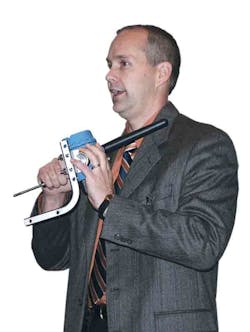The Emerson announcement, made on Jan. 11, is the latest volley in what appears to be an escalating public relations face-off between Emerson and Honeywell Process Solutions (http://hpsweb.honeywell.com), based in Phoenix, which is promoting is own wireless approach. While Emerson has emphasized a mesh wireless system at the sensor level, Honeywell’s mesh is at the plant communications level. Both companies are active with industry standards groups including the SP100 committee of the Instrumentation, Systems and Automation Society (ISA).Wireless rootsEmerson Process’ Europe, Middle East, Africa group invited European press, plus Automation World and another North American magazine, to Bologna, Italy, for the 2.4 GHz products announcement. Bologna is the birthplace of Guglielmo Marconi and site of his early laboratory, where he developed wireless telegraphy and performed other wireless research. The press was further treated to a tour of Marconi’s lab that is still preserved at the villa where he worked.Field trials with several North American and European customers over the last three years have demonstrated greater than 99 percent network reliability, Emerson says, and an installed cost that is as much as 90 percent lower than a wired equivalent. Emerson’s “Smart Wireless” solutions combine self-organizing wireless network technology and gateways with wireless-enabled Rosemount measurement transmitters and AMS Suite: Intelligent Device Manager predictive maintenance software, all seamlessly integrated with Emerson’s DeltaV and Ovation automation systems or with legacy hosts.Self-organizing networks are highly reliable because they allow wireless devices to serve as alternate communication paths, providing redundancy that enables more than 99 percent of field network messages to reach their destination. Networks using Emerson’s technology are scaleable from five to 100,000 devices.“When BP and Emerson started ex-ploring the possibilities of
new wireless technologies to support additional measurments in our refinery environment, we faced daunting challenges,” said Tasos Anastasiou, project manager for wireless technologies with the Refining Technology Office of BP p.l.c., the London-based energy company. “The dense metal environments that we operate in are less than ideal for the deployment of wireless.“The initial results proved very encouraging and gave both BP and Emerson the drive to push this technology to the next level and exploit its full capabilities,” continued Anastasiou. “The commercial release of Emerson’s Smart Wireless solution results from a very successful collaboration between our two companies, mutually sharing technology knowledge and operational experience to develop a very innovative solution that can add real business value.” Going to schoolEmerson is offering 19 new online training courses on various aspects of wireless for process automation. Designed for anyone who uses automation to improve plant performance, the new courses are available free through PlantWebUniversity.com, Emerson’s educational Web site. Five more courses will be available soon, and all 24 courses will later be translated into Spanish and Chinese, the company said.Based on Emerson’s experience in implementing its Smart Wireless solutions for customers, the courses are said to be practical, concise and free of marketing hype. Each can be completed in about 15 minutes and is available at no charge to anyone with an Internet connection anywhere in the world. Subject matter includes: what is wireless; wireless standards; wireless myths; self-organizing networks; and wireless applications.
new wireless technologies to support additional measurments in our refinery environment, we faced daunting challenges,” said Tasos Anastasiou, project manager for wireless technologies with the Refining Technology Office of BP p.l.c., the London-based energy company. “The dense metal environments that we operate in are less than ideal for the deployment of wireless.“The initial results proved very encouraging and gave both BP and Emerson the drive to push this technology to the next level and exploit its full capabilities,” continued Anastasiou. “The commercial release of Emerson’s Smart Wireless solution results from a very successful collaboration between our two companies, mutually sharing technology knowledge and operational experience to develop a very innovative solution that can add real business value.” Going to schoolEmerson is offering 19 new online training courses on various aspects of wireless for process automation. Designed for anyone who uses automation to improve plant performance, the new courses are available free through PlantWebUniversity.com, Emerson’s educational Web site. Five more courses will be available soon, and all 24 courses will later be translated into Spanish and Chinese, the company said.Based on Emerson’s experience in implementing its Smart Wireless solutions for customers, the courses are said to be practical, concise and free of marketing hype. Each can be completed in about 15 minutes and is available at no charge to anyone with an Internet connection anywhere in the world. Subject matter includes: what is wireless; wireless standards; wireless myths; self-organizing networks; and wireless applications.
About the Author
Gary Mintchell
Editor in Chief
Sign up for our eNewsletters
Get the latest news and updates

Leaders relevant to this article:
